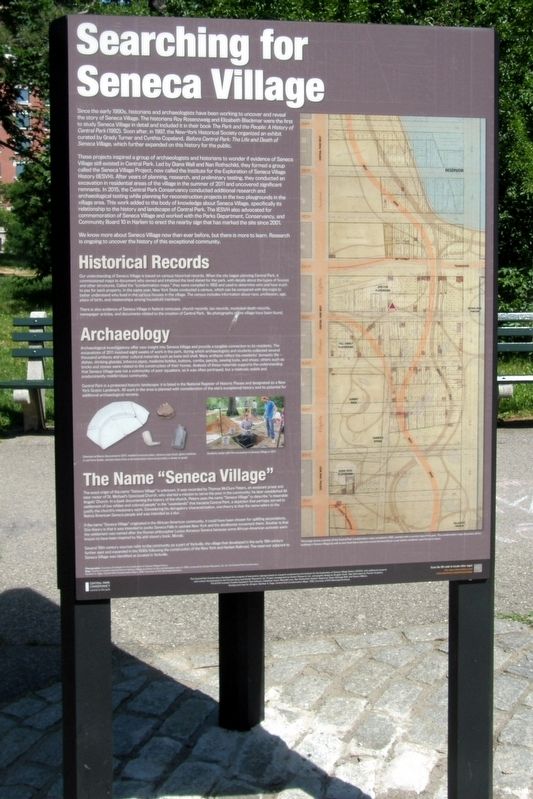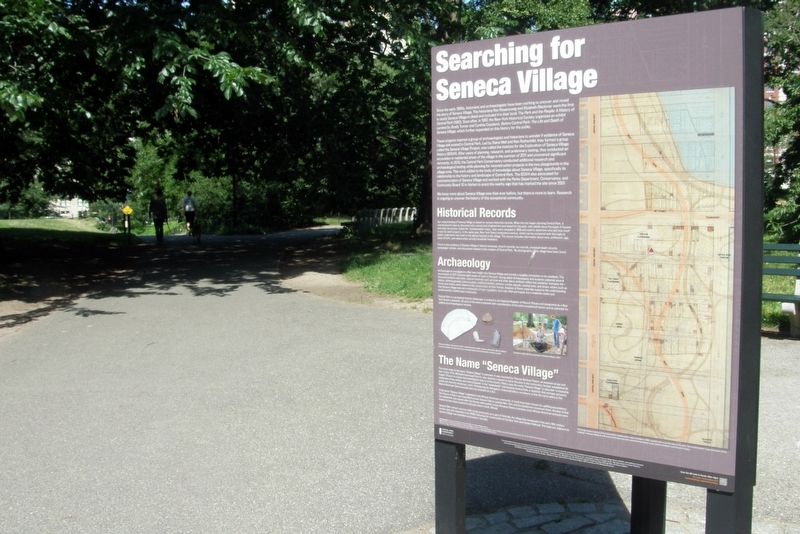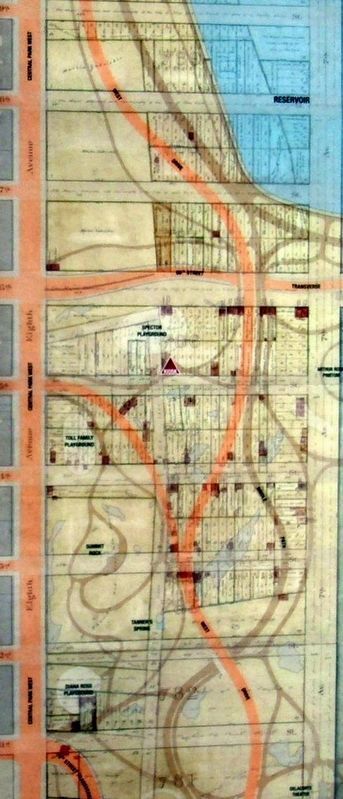Central Park West Historic District in Manhattan in New York County, New York — The American Northeast (Mid-Atlantic)
Searching for Seneca Village
Since the early 1990s, historians and archaeologists have been working to uncover and reveal the story of Seneca Village. The historians Roy Rosenzweig and Elizabeth Blackmar were the first to study Seneca Village in detail and included it in their book The Park and the People: A History of Central Park (1992). Soon after, in 1997, the New-York Historical Society organized an exhibit curated by Grady Turner and Cynthia Copeland, Before Central Park: The Life and Death of Seneca Village, which further expanded on this history for the public.
These projects inspired a group of archeologists and historians to wonder if evidence of Seneca Village still existed in Central Park. Led by Diana Wall and Nan Rothschild, they formed a group called the Seneca Village project, now called the Institute of Seneca Village History (IESVH). After years of planning, research, and preliminary testing, they conducted as excavation in residential areas of the village in the summer of 2011 and uncovered significant remnants. In 2015, the Central Park Conservancy conducted additional research and archaeological testing while planning for reconstruction projects in the two playgrounds in the village area. This work added to the body of knowledge about Seneca Village, specifically its relationship to the history and landscape of Central Park. The IESVH also advocated for commemoration of Seneca Village and worked with the Parks Department, Conservancy, and Community Board 10 in Harlem to erect the nearby sign that has marked the site since 2001.
We know more about Seneca Village now than ever before, but there is more to learn. Research is ongoing to uncover the history of this exceptional community
Historical Records
Our understanding of Seneca Village is based on various historical records. When the city began planning Central Park, it commissioned maps to document who owned and inhabited the land slated for the park, with details about the types of houses and other structures. Called the “condemnation maps”, they were completed in 1855 and used to determine who and how much to pay for each property. In the same year, New York State conducted a census, which can be compared with the maps to better understand who lived in the various houses in the village. The census includes information about race, profession, age, place of birth, and relationships among house members.
There is also evidence of Seneca Village in federal censuses, church records, tax records, municipal death records, newspaper articles, and documents related to the creation of Central Park. No photographs of the village have been found.
Archaeology
Archeological investigations offer new insight into Seneca Village and provide a tangible connection to its residents. The evacuations of 2011 involved eight weeks of work in the park, during which archeologists and students collected several thousand artifacts and other cultural materials such as bone and shell. Many artifacts reflect the resident’ domestic life – dishes, drinking glasses, tobacco pipes, medicine bottles, buttons, combs, pencils, sewing tools, and shores; others such as bricks and stones were related to the construction of their homes. Analysis of these materials supports the understanding that Seneca Village was not a community of poor squatters as it was often portrayed, but as a relatively stable an predominately middle-class community
Central Park is a protected historic landscape: it is listed in the National Register of Historic Places and designated as a New York Scenic Landmark. All work in the area is planned with consideration of the site’s exceptional history and its potential for addition archeological remains.
The Name “Seneca Village”
The exact origin of the name “Seneca Village” is unknown. It was recorded by Thomas McClure Peters, an assistant priest and later rector of St. Michael’s Episcopal Church, who started a mission to serve the poor in the community; he later established All Angels’ Church. In a book documenting the history of the church, Peters uses the name “Seneca
Village” to describe “a miserable settlement of low white and colored people” in the “wastelands” that became Central Park, a description that perhaps served to justify the church’s missionary work. Considering this derogatory characterization, one theory is that the name refers to the native American Seneca people and was intended as a slur.
If the name “Seneca Village” originated in the African-American community, it could have been chosen for uplifting associations. One theory is that it was intended to evoke Seneca Falls in upstate new York and the abolitionist movement. Another is that the settlement was named after the Roman philosopher Lucius Annaeus Seneca because some African-American activities were known to have been inspired by his anti-slavery book, Morals.
Several 19th-century sources refer to the community as a part of Yorkville, the village that developed in the early 19th century further east and expanded in the 1830s following the construction of the New York and Harlem Railroad. The reservoir adjacent to Seneca Village was identified as located in Yorkville.
Erected 2020 by Central Park Conservancy.
Topics. This historical marker is listed in these topic lists: African Americans • Parks & Recreational Areas • Settlements & Settlers. A significant historical year for this entry is 1997.
Location.
40° 47.048′ N, 73° 58.115′ W. Marker is in Manhattan, New York, in New York County. It is in the Central Park West Historic District. Marker can be reached from West 85th Street east of Central Park West. Touch for map. Marker is at or near this postal address: Central Park, New York NY 10024, United States of America. Touch for directions.
Other nearby markers. At least 8 other markers are within walking distance of this marker. Seneca Village Community (a few steps from this marker); Seneca Village Landscape (a few steps from this marker); The Wilson House (a few steps from this marker); Seneca Village (within shouting distance of this marker); African Union Church (within shouting distance of this marker); All Angels’ Church (within shouting distance of this marker); Gardens (within shouting distance of this marker); AME Zion Church (within shouting distance of this marker). Touch for a list and map of all markers in Manhattan.
Also see . . .
1. Seneca Village. Wikipedia entry (Submitted on April 15, 2021, by Larry Gertner of New York, New York.)
2. Seneca Village Site. Central Park Conservancy website entry:
Links to several related sub-topics (Submitted on April 15, 2021, by Larry Gertner of New York, New York.)
3. Seneca Village, New York City. National Park Service entry (Submitted on April 15, 2021, by Larry Gertner of New York, New York.)
Credits. This page was last revised on January 31, 2023. It was originally submitted on April 15, 2021, by Larry Gertner of New York, New York. This page has been viewed 192 times since then and 17 times this year. Photos: 1, 2, 3, 4. submitted on April 15, 2021, by Larry Gertner of New York, New York.



